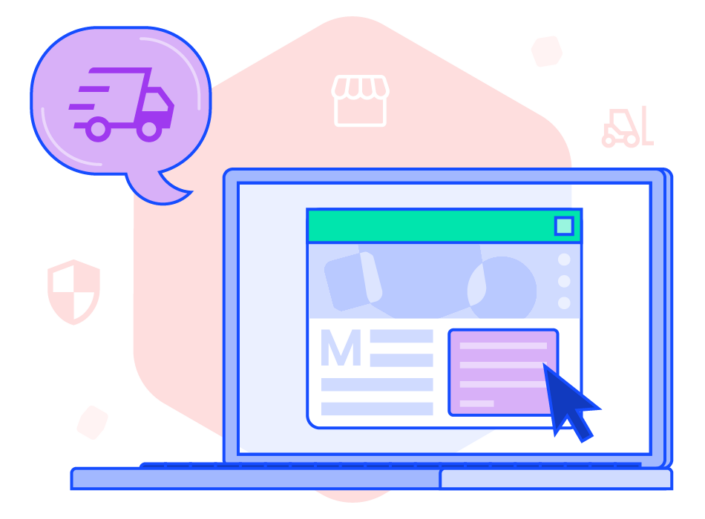Shipping products to customers can be daunting, especially if you’re new to the ecommerce game. With so many steps to follow and factors to consider, it can be difficult to know where to start when formulating your shipping strategy. In this guide, we will discuss everything from shipping costs, shipping carriers, and creating shipping labels to help you start shipping products to customers quickly and efficiently.
Step 1: Consider shipping costs
Shipping costs can significantly impact the success of your ecommerce business; therefore, it is essential to consider these costs when shipping products to your customers. A few factors will affect the cost of shipping, including the weight and size of your product, the shipping method you choose, and the distance your product is traveling.
To handle shipping costs effectively, you can employ a few different strategies:
Offer free shipping
Offering free shipping is one of the best shipping strategies to increase sales and customer loyalty. However, as you already know, if your customer isn’t paying for shipping, you are. Offering free shipping may seem like it’s easier said than done when it comes down to maintaining healthy profit margins on your products, but these tips will make it easier on your business’s pocketbook.
- Increase the price of your product. Raising the price a bit can cover (fully or partially) the shipping costs. This allows you to push a portion of the shipping costs onto your customers while technically making the shipping free for them.
- Offer free shipping on specific orders. If you’ve ever shopped online, you’ve seen certain businesses offer free shipping for “orders over $50” or some other order total. This strategy is great because it allows you to encourage your customers to spend a certain amount of money to make their shipping free, resulting in a win-win for everyone. This makes it easier for you to sell more products, make more money, and only pay for shipping costs on larger orders.
- Offer free shipping on special occasions. If you want consumers to purchase from your business, you have to either offer a unique product or a good deal on a common product. If you offer free shipping during the holidays or for a loyal customer’s birthday, people will be a lot more likely to choose your product over a competitor that does not offer free shipping.
Charge real-time carrier rates
Charging real-time carrier rates is another highly effective strategy for shipping. You can achieve this with the help of EasyPost’s rating API, which generates live pricing from multiple different shipping carriers in real time. This way you and your customers have access to the best rates at any given moment.
Charge a flat rate
Some carriers, like USPS, offer flat rate shipping options that can help you minimize and simplify your shipping costs. Charging a flat rate can be very effective if you sell products that have similar weights and sizes. However, if you sell products that vary greatly in size and weight, flat rate shipping may not be the best option for your ecommerce business.
Step 2: Choose a shipping carrier
Many different shipping carriers are available to businesses, so choosing one that best meets your needs is essential. When choosing a shipping carrier, consider the following factors:
Reliability
When choosing a shipping carrier, reliability is a significant factor to consider. After all, you want your shipments to arrive safely and on time. You can know how reliable a carrier is by checking the level of service rates (LOS). The higher the LOS rate, the more reliable the carrier, while the lower the LOS rate, the less reliable the carrier. As an ecommerce business, you aim to retain your customers by ensuring they’re satisfied with the service, and a reliable shipping carrier will help you achieve this goal.
Availability
This refers to the carrier’s coverage area and destinations they can deliver products to. You want to ensure that the carrier you choose has the coverage you need to reach your customers. Simply check the coverage map of the carrier you’re considering to know where they can ship and how quickly they can get your products to your customers.
Cost
Cost is another factor you should consider when choosing a shipping carrier. The cost of shipping will vary depending on the carrier you choose. Each carrier has its pricing structure, so it is vital to do extensive research before settling on a carrier.
When considering pricing, you should also consider the quality of service you will get. You may be tempted to choose a cheap carrier, thinking you will save on cost. However, you should understand the carrier’s pricing and business priorities as well, such as quality, client satisfaction, and safe delivery, before making a decision.
Size/weight of products
The size and weight of your products are essential considerations when choosing a shipping carrier and determining how to ship products. Small, lightweight items can be shipped via USPS First Class Mail, while larger, heavier items will need to be shipped via USPS Priority Mail or FedEx Ground. You may need to use a freight service if you have very large or heavy items.
Distance
As an ecommerce business, you must carefully consider which shipping carrier you want to partner with. When it comes to distance, you need to think about how far your products will travel. Distance will be a minor factor if you’re only shipping within the same country. However, if you’re shipping internationally, you need to ensure your chosen carrier has the infrastructure to handle longer distances.
Delivery times
When customers order products, they often expect shipping and delivery times to take the shortest time possible. This makes the delivery time a significant factor you should consider when deciding on a shipping carrier. If your products are shipped fast, it can positively impact your business growth by retaining existing customers and getting new referrals.
Many shippers give customers a delivery window so they know when to expect their package. Some will guarantee a delivery date. Before choosing a carrier, ensure they can deliver products according to your needs – whether that means a delivery window is fine or if you need a product delivered more precisely. This will save you a lot of time and stress caused by late deliveries.
Insurance
Insurance protects your shipment if it is lost or damaged in transit. It is important to note that not all shipping carriers offer insurance, so be sure to check with your carrier of choice before sending your shipment. Some carriers require you to purchase insurance through them, while others allow you to purchase insurance through a third party. If you purchase insurance through a third party, get a certificate of insurance from the insurer and keep it on hand in case you need to file a claim.
Tracking
Tracking is another factor you should consider when choosing a shipping carrier. With tracking service, the customer can know the real-time location of their package and the estimated time it will take for the package to be delivered. As a business, you can ensure your customer’s package is delivered on time by tracking and communicating unexpected delays to your customers. Tracking service can be a game changer in your business, so when choosing a carrier, choose one that offers tracking services.
Step 3: Determine a fulfillment strategy
The third step in shipping products to customers is determining your fulfillment strategy. Several factors, including your budget, the size and weight of your products and your customer base, will determine your fulfillment strategy. When it comes to fulfillment, you have the following options:
Self-fulfillment
Self-fulfillment means you handle the entire process yourself, from packaging and shipping to customer service. The advantages of self-fulfillment include complete control of the experience you want to give your customers. It is also economical since you don’t need to hire a third-party logistics company to fulfill your orders. However, self-fulfillment can be time-consuming, complicated to expand, and limited to specific products.
Warehouse fulfillment
Warehouse fulfillment is when you employ a third-party warehouse to handle the fulfillment process on your behalf. When you decide to work with a warehouse, you will have your inventory in their warehouse, and when an order is made, the warehouse will automatically pick, package and ship on your behalf.
Dropshipping
Dropshipping is when a supplier ships the product directly to the customer on your behalf. With drop shipping, you pay for the product when the client places an order through your ecommerce site. Once you pay, you send the customer’s shipping address to your vendor, and they ship the product to the customer directly.
Step 4: Decide how to package your products
Packaging plays an integral role in the success of any product. It’s a critical factor in brand recognition and customer experience. It also helps people differentiate your product from your competitor’s products. Shipping your product in the right packaging affects how buyers perceive your products. It’s essential to take the time to think about the packaging for your products. Here are some packaging options you can choose from:
Custom vs. generic packaging
Custom packaging can be more expensive than generic packaging, but it offers the opportunity to showcase your brand better. Custom packaging may be the right choice if you want to build brand recognition and create a solid visual identity. Generic packaging is often more functional and sustainable, but it may do less to promote your brand.
When deciding between custom and generic packaging, weigh the cost against the benefits of each option to find the best solution for your products.
Boxes vs. padded envelopes
Two main types of packaging are used to send products through the mail: boxes and padded envelopes. Each has advantages and disadvantages, so you’ll need to decide which is best for your product and shipping needs.
Boxes are more durable than padded envelopes and can better protect your product during shipping. They can also be more expensive to ship, since they often weigh more than padded envelopes.
Padded envelopes offer less protection than boxes but are much cheaper to ship. They’re a good option for lighter products that don’t need as much protection during shipping.
In addition to packaging, you have several options for cushioning fragile products when in transit, including bubble wrap, packing peanuts, and tissue paper. Tissue paper is gentle, cheap, and perfect for wrapping fragile items. Packing peanuts can be used to insulate fragile items during shipping. Bubble wrap is excellent for protecting fragile items; it’s more expensive than the other two options but works very well.
Environmentally friendly packaging
If your customers or your company are focused on environmental issues, environmentally friendly packaging is a great option. A product designed and marketed as eco-friendly should follow through with packaging and carbon neutral shipping options. Options such as biodegradable packing peanuts, air pillows made from recycled materials, and sustainably sourced materials such as mushrooms or seaweed are available and will help your customers feel better about their purchase.
Step 5: Create shipping labels
Creating labels is an essential part of shipping a package, and it can be more complicated than you may think. The shipping label contains the information that gets your package where it needs to go, so you want to ensure it’s accurate and readable.
You can create shipping labels in a variety of ways:
- Use a carrier’s online services to create a label, then print it at home or visit the carrier and have them print off the shipping labels you need. If you are shipping more than a few packages, this will quickly become cumbersome.
- Integrate individual carriers with your ecommerce software platform to create and print labels more easily. The drawback here is the part about integrating carriers individually. With hundreds of carrier options available, that’s a lot of individual integrations – assuming you want the benefits of multi-carrier access.
- Use a shipping label solution that gives you automatic access to multiple carriers and simple label creation. Integrating with EasyPost’s Shipping API, for example, gives you access to hundreds of carriers, and our Create Label tool makes it easy to create labels individually, in bulk, or even automatically.
Once your label is created, you can print it with any printer. However, if you have high shipping volumes, a thermal label printer is a great investment. They are built to print labels, and they do it well.
Make sure to place the label on the top of the package in a visible place and not folded over any edges so important information isn’t obscured. If you’re using an inkjet printer and regular paper, it’s fine to cover the label with transparent tape.
Step 6: Send customer tracking information
If you’re using a shipping service like UPS, FedEx, or DHL, you’ll need to provide your customer with a tracking number so they can follow the progress of their shipment. An API like EasyPost makes it simple to share tracking information with your customers. With EasyPost, you’ll have real-time shipment updates for all package movements on branded tracking pages.
Step 7: Schedule pick up or drop off
You can choose to have a carrier pick up your packages – if they offer that service – or drop your packages off. With carrier pickup, a delivery driver will come to your home or business to pick up your package. With drop off, you take your package to the shipping facility.
Carrier pickup is the most convenient option for shipping packages. The driver will come to you so you don’t have to go out of your way to drop the package off. However, you will have a limited window of time in which the driver can pick up your package. If you’re unavailable during that window, you’ll have to reschedule the pickup or drop the package off at the shipping facility.
Dropping packages off is less convenient than carrier pickup, but it gives you more flexibility regarding when you can ship your package. You can drop it off at the warehouse, even before it’s opened or after it’s closed for the day.
Step 8: Consider shipping API/software
One option to consider when shipping packages is to use a shipping API or software to automate the process. This can be a great option if you have a high volume of packages to ship out regularly, as it can save you time and money in the long run.
You should keep a few things in mind if you decide to go this route. First, you’ll need to find a reliable shipping API like EasyPost that will work well for your business. EasyPost’s REST API provides easy access to multiple carriers, address verification, tracking, easy label creation, rate shopping, and eco-friendly carbon offsets.
Next, research the solution you’re considering to make sure you won’t be causing yourself more headaches than you’re solving. For an API solution, specifically, check into reliability and uptime during your busiest shipping times, make sure they have a great support team, and talk to them about discounted rates you may be eligible for. It doesn’t make sense to pay more than you have to for shipping.
Shipping products to customers is an integral part of doing business. With the proper planning and resources, you can ensure that you’re securely and efficiently shipping your products to your customers on time and in good shape. Following this step-by-step guide on how to ship products to customers will guarantee a smooth shipment process for you and your customers.
Learn how the EasyPost Shipping API simplifies small business logistics.




